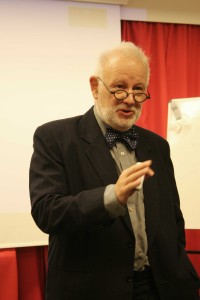
Trying to plunge as deep as possible into the spirit of Renaissance Florence, and to create a full image of the time in which some of the biggest names in art, like Leonardo or Michelangelo, worked, the AY students came across a text which, although hard to read, presents a very important study of the subject in its time. This text is Walter Pater’s The Renaissance: Studies in Art and Poetry, presented by Professor Barrie Bullen, a guest lecturer from the School of English and American Studies, University of Reading.
The book seems to have caused some controversy when it was published, and certainly was a hindrance to Pater’s academic career at Oxford University. Due to the claims that he made in this book, Pater was never promoted and even faced the possibility of losing his job. But what was it that stirred the public so much that it resulted in such consequences for the author? Professor Bullen tried to explain this by justifying two important claims: that the Renaissance as we understand it was actually a term invented in the 19th century, and that its importance in this century was partly based on affirming sexual desire as a human trait.
19th century England was a place where revived interest in the Middle Ages resulted in a “passion for the Gothic style”. This passion is reflected in architecture, especially through the works of the most eminent English architect of the 19th century, August Welby Pugin, famous for his work on the Houses of Parliament in London. Gothic architecture was perceived as the style most closely connected to Christian doctrines. It is only natural that Pugin, a fervent Catholic, would use this style repeatedly and would promote it as superior to other styles. Renaissance art and style was perceived as “pagan, godless and proud”; as being interested in material rather than spiritual qualities, and as conforming to patterns and striving towards physical and proportional perfection in contrast with the gothic style, which allowed freedom of expression.
This insistence on moral life and exclusion of all bodily pleasures brought a reaction from a number of people in the 19th century. Among the first was Dante Gabriel Rosetti, who managed to shift the direction of British art away from medieval influence. Although his work was harshly criticized, it was successful in stirring a “protest against Gothic values and abnegation of the flesh”, as Professor Bullen said. Classical art was rediscovered and it triggered a pursuit of the pleasures of the senses and of the imagination and, what was most interesting for Pater, a worship of the male body.
In his work, Pater praises Botticelli as an important figure, who, although he worked on religious paintings, was actually interested in producing a humanist presentation of the Christ child and the Virgin Mary. This book seems to put art in a more important position than religion, which is one of the main reasons for the problems it caused Pater. Another reason Pater’s book was considered odd at the time is the use of language: he was very aware of its impact and worked meticulously on his prose, creating a style that some found difficult to follow. The fact that Yeats, years later, turned this prose in poetry, proves that Pater was misunderstood during the age in which he lived.
Professor Barrie Bullen’s main teaching interests are the Pre-Raphaelites, Thomas Hardy, Virginia Woolf and the ‘Bloomsbury Group’. His research interests focus on the boundary between literature and the visual arts in the nineteenth and twentieth centuries. His publications include: The Pre-Raphaelite Body: Fear and Desire in Painting, Poetry, and Criticism (Oxford: The Clarendon Press, 1998), Byzantium Rediscovered (Phaidon Press, 2003), Continental Crosscurrents: British Criticism and European Art 1810-1910 (Oxford: The Clarendon Press, 2005), The Expressive Eye: Fiction and Perception in the Work of Thomas Hardy, (Oxford: The Clarendon Press, 1986), The Myth of the Renaissance in Nineteenth-Century Writing (Oxford: The Clarendon Press, 1994) and other publications on the Romantic poets, 19th century art critics and novelists, Bloomsbury, W.B. Yeats and D.H. Lawrence.
Article by Elena Volkanovska (’09, Macedonia)
